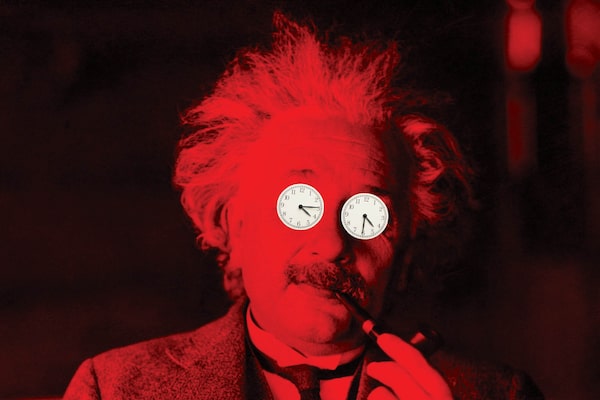Brian Greene is a professor of physics and mathematics and director of Columbia University’s Center for Theoretical Physics. His books include The Elegant Universe, The Fabric of the Cosmos, The Hidden Reality and Until the End of Time: Mind, Matter, and Our Search for Meaning in an Evolving Universe, which will be published in February.

Albert Einstein.PHOTO ILLUSTRATION: THE GLOBE AND MAIL. SOURCE IMAGE: AP PHOTO
The past century witnessed spectacular upheavals to our understanding of space and time. The next decade holds the promise of taking these insights to an entirely new level.
Everyday experience affirms that if you and I measure the lengths of objects or the durations of events, our results will agree. But in June, 1905, Albert Einstein realized that everyday experience is deeply misleading. During the course of five intense weeks that he described as having a storm break out in his mind, Einstein established that if you and I are moving relative to one another, our watches will tick off time at different rates and our tape measures will have different lengths. At familiar speeds, the effects are tiny, explaining why, for so long, no one had noticed.
But Einstein’s mathematical derivation of the conclusion was so simple, relying on nothing more advanced than high-school algebra, that the community of physicists quickly relinquished common intuition in favour of a startlingly new flexibility of space and time. There is now no controversy that, for example, were you to take a round-trip journey at nearly light speed, upon landing back on Earth, you would find that you had travelled far into the future.
In 1915, Einstein went further still, realizing that distortions to space and time could be yet more severe: Massive objects cause the fabric of spacetime to sag, somewhat like a bowling ball resting on a trampoline. Such spacetime curvature then affects the motion of nearby objects, such as a planet moving near a star, leading to a new and demonstrably deeper understanding of gravitational force: Gravity is nothing but grooves in the spacetime fabric that guide an object’s motion.
These results constitute Einstein’s special and general theories of relativity, and have led to profound insights into the origin of the universe, the nature of black holes and, most recently, gravitational waves – ripples in the very fabric of spacetime.
Even so, Einstein’s relativity is silent on what space and time actually are. When we speak of the spacetime fabric, is that metaphor? Or are space and time material things? And if so, can we identify the threads stitching the spacetime fabric? Current research suggests that the answers may not be far off, and moreover may come from an entirely distinct set of insights that, remarkably, also reach back to Einstein.
Einstein was awarded the 1921 Nobel Prize, but not for his discoveries in relativity. The Nobel committee cited Einstein’s work on the photoelectric effect, which was one of the earliest and most influential papers on what would become quantum mechanics – the curious laws that are most manifest in the microworld of atoms and particles. As quantum mechanics developed, Einstein grew ever less comfortable with its unfamiliar portrayal of reality. He recoiled at a world governed by probabilities, musing that if this were truly how reality works, he’d rather be a croupier than a physicist.
In 1935, working with two colleagues, Einstein believed that he had finally pinpointed quantum mechanics’ Achilles heel. Relying on a feature of the theory known as quantum entanglement, Einstein argued that two distinct and widely separated particles could act as though they are single entity. One member of the pair might be in New York and the other might be in Calgary. Yet, were you to interact with one of the particles, quantum mechanics predicts that you would instantaneously influence measurable properties of the other, even though it is thousands of kilometres away.
Einstein considered this implication of quantum theory to be ludicrous, famously deriding it with the characterization “spooky.” He envisioned that his colleagues would have to agree that quantum mechanics was, at best, a provisional description of the world.
Einstein misjudged his colleagues. They did nothing of the sort. They doubled down on quantum mechanics, a position history has since justified. Decades after Einstein died, experiments established that spooky connections are real. Moreover, some of the intellectual descendants of these die-hard quantum adherents now believe that Einstein unwittingly illuminated a quality of the microworld that may be essential to understanding the very fabric of spacetime.
Physicists have realized that quantum entanglement is relevant not only to particles within space but to space itself. Space is permeated by fields – electric, magnetic, nuclear, gravitational – and depending on their overall configuration, quantum mechanics establishes relationships between the properties of the fields at different locations. Notably, when the fields have the least amount of energy possible – the emptiest that empty space can be – these relationships amount to quantum mechanics entangling different locations throughout empty space.
Brilliant scientists at the forefront of research have leveraged the mathematics underlying such connections to argue that the fabric of space may in fact be stitched by the threads of quantum entanglement. Cut the invisible quantum threads and the fabric of space would unravel.
While these ideas are tentative, they are enormously promising. For hundreds of years, physicists took space and time as givens – bedrock ingredients in the makeup of reality. Einstein then breathed life into space and time, jolting them out of the rigid inflexibility inherent in the intuitive Newtonian perspective. And in the coming years, quantum mechanics may help us understand the weave of the spacetime fabric, perhaps explaining why they exist at all. How wonderfully ironic that the very theory Einstein so thoroughly resisted may provide the deepest rationale for the foremost ingredients in his life’s work: space and time.
Keep your Opinions sharp and informed. Get the Opinion newsletter. Sign up today.